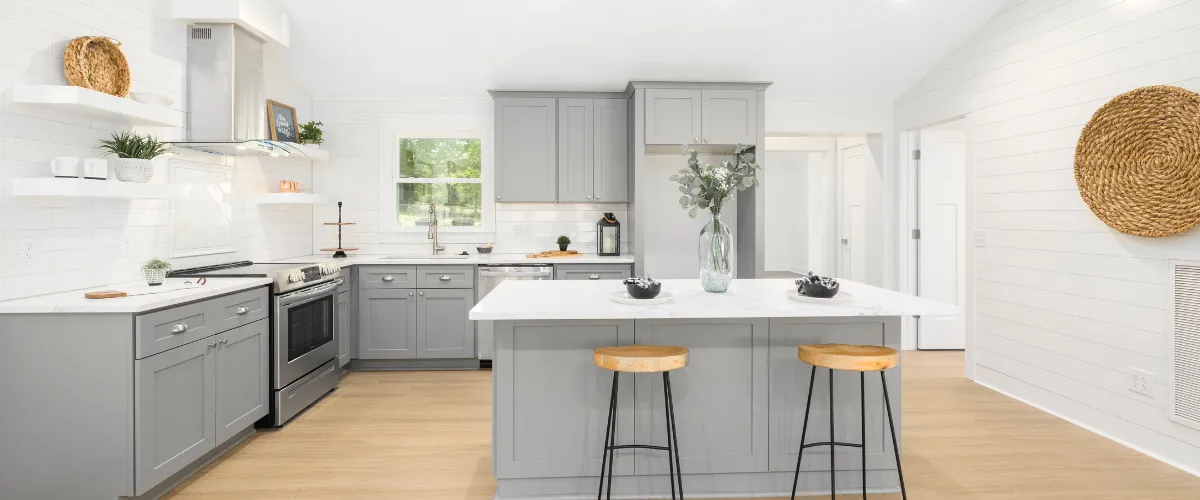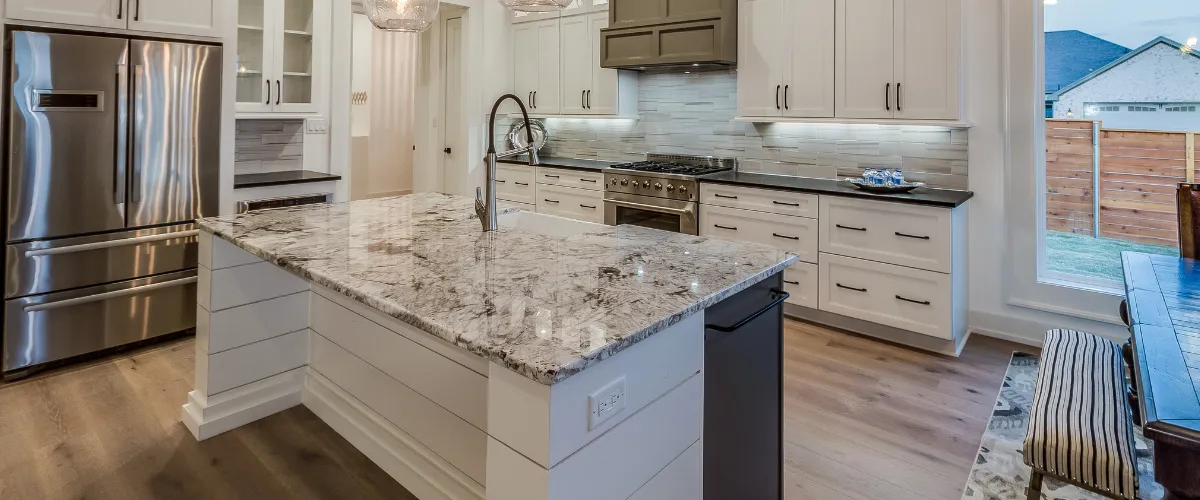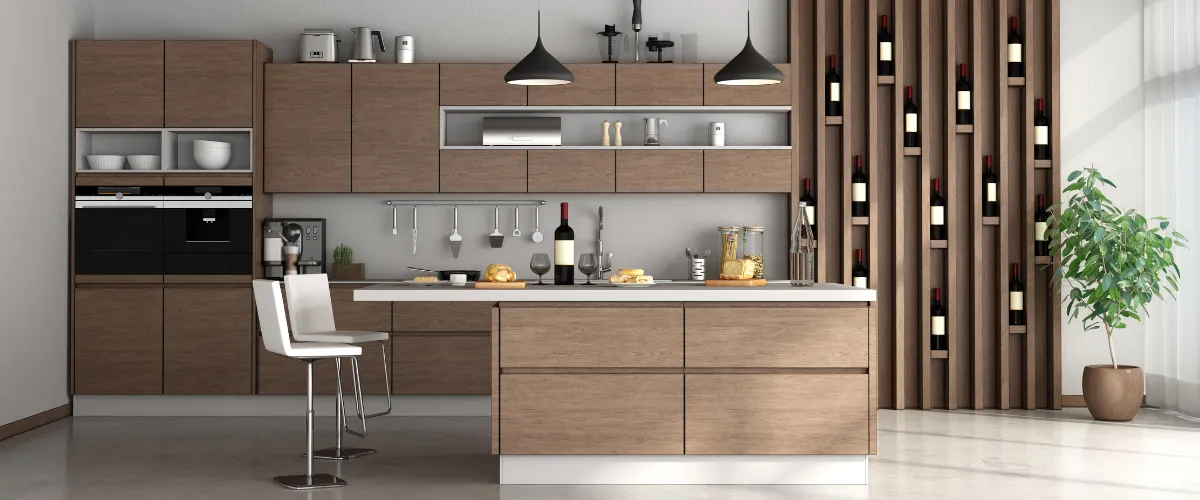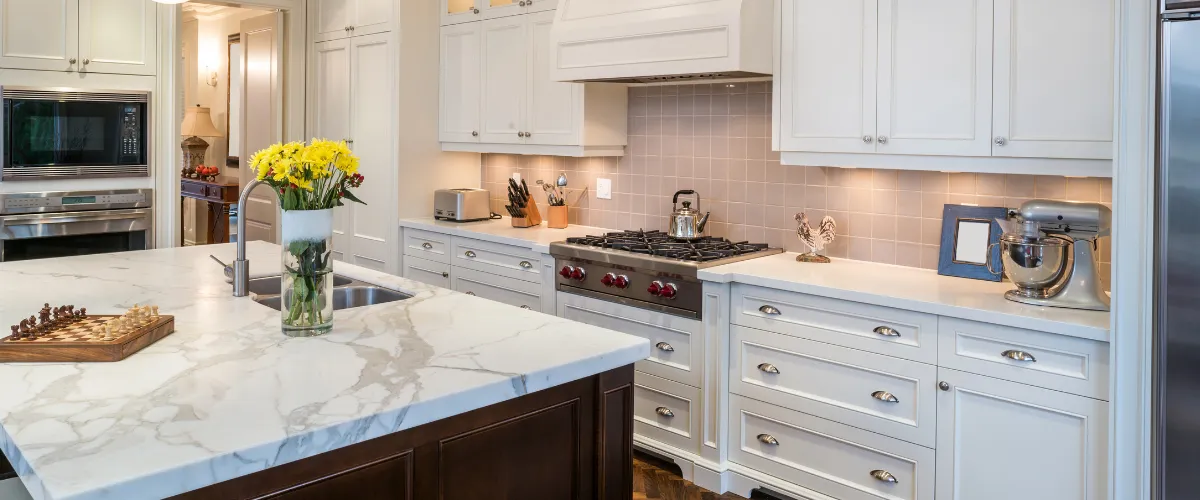Different Types Of Kitchen Islands And Their Benefits
Choosing the right kitchen island can be tough. Did you know there are many types? This article will guide you through different types of kitchen islands and their benefits to find what fits your space best.
Keep reading!

Key takeaways
- Galley kitchen islands make smart use of kitchen space.
- A galley island can turn a tight kitchen into a functional workspace.
- A double kitchen island offers abundant space for cooking and dining.
- The spacious layout creates a convenient environment for preparing meals or hosting gatherings without feeling cramped.
Galley Kitchen Island
Benefits: Efficient use of space
Galley kitchen islands make smart use of kitchen space. They fit well in long, narrow kitchens, saving floor space while giving more counter space for food prep and storage. This setup helps to keep things organized and within easy reach.
A galley island can turn a tight kitchen into a functional workspace.
This style also supports the workflow with ample space on both sides. It lets people prepare meals without bumping into each other. Galley islands often include built-in appliances or extra storage under the countertop, optimizing the available area even further.

Drawbacks: Limited seating options
Galley kitchen islands have a big downside: not much room for seats. This problem means fewer spots for eating or hanging out in the kitchen. You might fit a couple of bar stools on one side, but that’s often it.
For families who enjoy meals together in the kitchen, this can be a disappointment.
The design focuses more on extra counter space and storage than on seating space. This makes galley style islands great for food preparation but not as good for casual dining with friends or family.
If your dream kitchen includes a spot where everyone gathers around to chat and eat, a galley island might not meet your needs.
Rolling Kitchen Island
Benefits: Mobility for flexible use
A rolling kitchen island brings convenience right to your fingertips. It moves around easily, making it perfect for homes where extra space is always needed. Whether you’re preparing meals or entertaining guests, this mobile island can be pushed out of the way when you need more room.
It’s a great choice for people who love to rearrange their kitchen layout often.
Moving your work area closer to your dining area makes serving food easier.
With a rolling kitchen island, anyone can turn any part of their house into a temporary meal prep space or a casual dining spot. Unlike fixed islands, these mobile versions allow you to adapt quickly and efficiently to any cooking situation.
This flexibility makes the rolling kitchen island an indispensable tool in modern kitchens.
Drawbacks: Less stability
Rolling kitchen islands offer flexibility but may compromise stability. This can be a concern, especially when dealing with heavy or hot items as it may pose a risk of tipping over.
The wheels can also make the island move unexpectedly, causing accidents and spills in the kitchen. Moreover, the lack of firmness might not provide an ideal workspace for certain activities like chopping ingredients or rolling dough.
The U-shaped kitchen islands can sometimes feel less stable due to their sprawling design. It may not be suitable for those who prefer a solid and immobile surface during meal preparation or other culinary activities.
This drawback should be considered, especially if there are children around, as it could potentially pose safety risks in a bustling kitchen environment.

Double Kitchen Island
Benefits: Ample space for cooking and dining
A double kitchen island offers abundant space for cooking and dining. It provides extra room for food preparation, allowing multiple cooks to work together without feeling cramped.
Moreover, it offers plenty of space for setting up a casual dining area where family and friends can gather, making it an ideal spot for entertaining guests during meals or social gatherings.
The U-shaped kitchen island also provides ample space for cooking and dining. With its design maximizing countertop and storage space, it allows for efficient meal preparation while offering enough room to create a comfortable dining setting.
This type of island creates a focal point in the kitchen by providing additional countertop space which can be used as a serving area during meal times, adding both functionality and aesthetic appeal to the kitchen environment.
Drawbacks: Requires large kitchen area
Double kitchen islands offer generous space for cooking and dining, but they might not be practical in smaller kitchens where substantial kitchen area is necessary. The presence of this type of island could restrict movement in the kitchen, particularly in limited spaces.
It’s important to bear these considerations in mind when planning for a double kitchen island to guarantee sufficient open space in the kitchen.
Incorporating a double kitchen island calls for careful assessment of available square footage, considering potential trade-offs such as reduced walking space and restricted movement within the culinary workspace.
This configuration also requires heightened attention to ensure adequate proximity to built-in appliances or corner cabinets, while avoiding overcrowding with furniture-style islands or large countertops.
Striking a balance between functionality and aesthetics becomes critical when seeking to accommodate two islands within a confined layout. This can be challenging without compromising on comfort and practicality.
U-shaped Kitchen Island
Benefits: Maximum counter and storage space
The U-shaped kitchen island provides ample countertop space, allowing for efficient food preparation and cooking. The extra storage underneath also maximizes the organization of kitchen essentials, reducing clutter on countertops.
This type of island can accommodate multiple cooks at once and offers plenty of room for various appliances and utensils. With its functional design, it ensures that everything needed for meal preparation is within easy reach.
The spacious layout creates a convenient environment for preparing meals or hosting gatherings without feeling cramped.
Drawbacks: Can make the kitchen feel cramped
A U-shaped kitchen island can make the kitchen feel cramped because it takes up a lot of space. This can limit movement and make the kitchen area feel smaller than it actually is. It might be challenging to accommodate more people within this layout, especially if the space is already limited.
However, with clever design and organization, this drawback can be mitigated to some extent by ensuring efficient use of every inch available.
The key issue with U-shaped islands is that they need considerable room in order not to overpower the kitchen. The layout may also restrict flow and create a bottleneck effect when multiple people are using the space simultaneously.
Furniture Style Kitchen Island
Benefits: Adds aesthetic value and functionality
Furniture Style Kitchen Islands not only enhance the visual appeal of the kitchen but also improve its functionality. With a variety of designs and materials available, these islands contribute to the overall style statement of your kitchen.
The added storage and countertop space make meal preparation more efficient, while the opportunity for customized features such as built-in appliances and stainless steel countertops elevates both practicality and aesthetics.
Waterfall Kitchen Islands are crafted to enhance both the modern look and functionality of kitchens. They provide seamless counters that extend vertically to create a contemporary feel, allowing for easy cleanup while adding an elegant touch to any kitchen space.
Incorporating a waterfall island not only adds surface area but also serves as a stunning centerpiece in your kitchen, making it ideal for both day-to-day use and entertaining guests.
Drawbacks: Often more expensive
Shifting from the positive aspect of adding aesthetic value and functionality to kitchen islands, it’s important to recognize that this enhancement often comes with a higher price tag.
Introducing furniture-style kitchen islands or waterfall kitchen islands into your kitchen design can significantly raise the overall cost of a remodeling project. Factors such as material selection, custom designs, and additional features can lead to a substantial investment.
For example, choosing premium countertop materials like granite or marble for a furniture-style island can significantly increase costs. Similarly, selecting customized built-in appliances in a waterfall island may require careful planning and customization towards specific dimensions, resulting in increased expenses.
Moreover, specialized craftsmanship needed for these high-end options inherently raises their prices compared to more traditional alternatives. When looking for more than just extra storage space or counter room from your kitchen island design, be ready to invest in these luxurious but pricier choices.

Top Kitchen Island Manufacturers
IKEA: Known for affordable, stylish designs that cater to a wide range of kitchen island preferences.
KraftMaid: Offers custom designs and high-quality finishes tailored to complement any kitchen style.
Home Styles: Specializes in ready-to-assemble kitchen islands with innovative and functional features.
John Boos & Co.: Renowned for their robust butcher block islands suitable for both residential and professional kitchens.
Wayfair: Provides an extensive selection of diverse styles and materials at competitive prices.
Frequently Asked Questions About Kitchen Islands
Trust Our Experienced Team
Our team has perfected the art of kitchen remodeling over the years, delivering exceptional results. By choosing our industry professionals, you ensure quality work that ultimately saves money. Ready to start your kitchen remodeling project? Contact us at (816) 200-7741.
